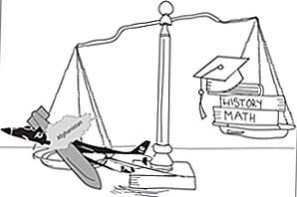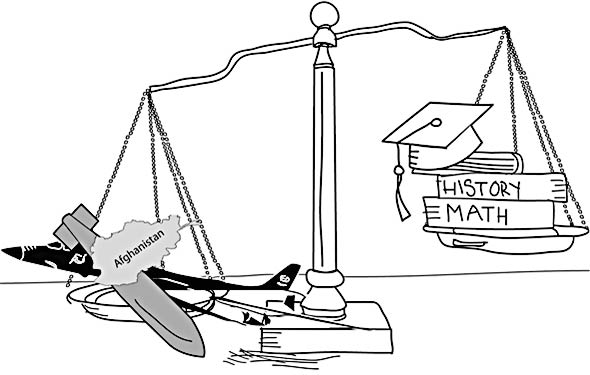OPINION
After more than a decade of military spending, higher education bears the scars of neglect.
The events of September 11, 2001, have had a profound impact on every aspect of American life, but what often goes overlooked are its effects on education.
As students, we don’t think about war every day. We are so preoccupied with tests, projects and the immediacy of college that we don’t wake up thinking to ourselves: It sure is a great day to be fighting two wars.
Being so distanced from the front lines keeps Afghanistan in the backs of our minds.
The Baby Boomers that created a formidable international economy with innovation learned through higher education are leaving the workforce. If they are replaced with less educated workers, our current downward economic spiral will continue. If half of the money spent in Afghanistan and Iraq over the last 11 years went toward funding our schools and universities, our nation would benefit for generations to come. More educated citizens solve problems quicker, are more innovative and less prone to cling to guns and God.
As it stands today, states are failing to provide affordable education opportunities because their hands are tied by lack of funding. Revenues are down and costs are up, forcing the cost on those who can least afford it, us.
State governments have the ultimate power to draft their education budgets, but imagine if some of the staggering cost of our two wars was given to California as a federal categorical grant designed to revive our suffocating universities. Brown University’s Watson Institute for International Studies estimated in 2011 that the wars in Iraq and Afghanistan could cost upwards of $4 trillion, accounting for inflation. That is roughly four times the estimate given by the Department of Defense in the same year. This is because, according to the report, the federal government is only estimating “war-related activities,” which do not include long-term commitments, aid to injured veterans and swelling interest rates. By comparison, in today’s economy, the Vietnam war would only have cost $738 billion.
If you take about half of that $4 trillion and divide it among our 50 states, the roughly $40 billion each state would receive is almost four times the amount California spent on higher education from 2010 to 2011.
If the federal government stepped in and committed to educating our students affordably, more students would enroll, creating more revenue for the state. Our more educated workforce would revive our weak economy.
Federal intervention would not make us a welfare state as some would argue, only an educated one.
There is support for this from U.S. Secretary of Education Arne Duncan.
“The key areas of growth in the new economy — fields like health care, technology and green energy — require us to get much better in subjects like math and science,” he said in a Nov. 2011 speech, “and do a better job of producing college graduates in these fields.”
But with the way things are going in Sacramento and Washington, education may very well end up in the private sector. For the first time in California’s history, students are paying more to the University of California system than the state is.
Increased privatization is detrimental to the education process because it forces an unnecessary burden on students while causing many to make decisions in their best financial interest rather than in the interests of their education.
If students cannot afford their education, no one’s interests are served.
State legislators promise a lot of rhetorical bull that sounds great on paper, but in reality, they are trying to yank our caps and gowns off our heads. California supposedly guarantees transfer spots for students from community colleges to Cal State campuses, but state legislators’ budget cuts are forcing them to contradict themselves.
The same people who promised to fight for our rights and best interests are leaving us for dead, but we can fix this. Our futures are not set in stone and we have everything we need right at our fingertips.
Social media, technology and the rapidity of globalization mean that now, more than ever, we can affect change. What we have in numbers, however, we lack in solidarity. We must decide on what we need now and move forward with a plan.
Your right to education should extend beyond the 12th grade and be guaranteed by both the federal government and the state you live in. If Duncan believes that “education and the economy are inextricably linked,” then the federal government needs to step up.
A college education is not a private investment like property or stocks. It is a public good.
Educate yourself beyond the classroom and push for federal legislation that mandates that states prioritize education and that state laws protect a student’s right to affordable and accessible education.
As students, our voices can challenge those in power.
There are immeasurable benefits to funding education over killing people. Through political action we can make our leaders see that, or remove them from office.
CONTACT YOUR REPRESENTATIVES:
- Ed Royce — 40th District
Orange, Anaheim, Stanton
1110 E. Chapman Ave., Suite 207,
Orange, CA 92866
Phone: (714) 744-4130 - Loretta Sanchez — 47th District
Santa Ana, Garden Grove
12397 Lewis Street, Suite 101,
Garden Grove, CA 92840
Phone: (714) 621-0102
RELATED STORY (Views – April 23, 2012): The 9/11 Generation: Living in a world at war
- In Photos: Fiestas Patrias 2025 - September 25, 2025
- The two-party system is failing us. - October 19, 2024
- Read our Fall 2023 Print: Vol. 100 No. 1 - October 23, 2023











